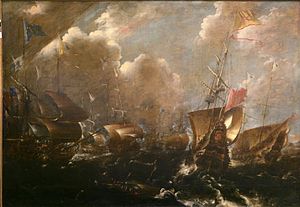Battle of Getaria
This article needs additional citations for verification. (September 2014) |
| Battle of Getaria | |||||||
|---|---|---|---|---|---|---|---|
| Part of the Franco-Spanish War (1635) | |||||||
 The Battle of Guetaria, by Andries van Eertvelt | |||||||
| |||||||
| Belligerents | |||||||
|
|
| ||||||
| Commanders and leaders | |||||||
|
Claude de Launay-Razilly |
| ||||||
| Strength | |||||||
|
27-44 ships 7-8 fireships | 12-18 galleons | ||||||
| Casualties and losses | |||||||
| No ship lost. 40 dead.[1] | All galleons destroyed, except one. 4,000[2] – 5,000 dead.[3] | ||||||
The Battle of Getaria or the Battle of Guetaria are the names given to a battle in the Franco-Spanish War (1635 - 1659), which took place on 22 August 1638 at Getaria, northern Spain, when a French fleet under de Sourdis attacked and destroyed a Spanish fleet under Lope de Hoces.
The battle
In June 1638 a large French army crossed the Pyrenees to besiege Fuenterrabía. The French army was accompanied by a fleet between 27 and 44 French warships under Henri de Sourdis, who had to stop any help reaching Fuenterrabia over the sea.
De Hoces was ordered to attack the French fleet, but had only 12 galleons and some smaller ships at his disposal. The Spanish fleet sailed into the harbor of Getaria on August 17 and took up defensive positions close to the shore.
This had several advantages: The largest French ships could not approach because of the shallow waters, the usual French tactics of close combat followed by boarding was impossible and the Spanish fleet had supporting fire from the shore.
De Sourdis decided to first batter the Spanish fleet with his superior fire power, then send in his fireships and cut off any escape route with his smaller vessels.
But first the wind had to blow towards the shore, which happened on August 22. The French plan works extremely well. De Hoces had made no precautions against fireships, because this weapon was normally not used by the French, and de Sourdis had his fireships disguised as normal war vessels. The entire Spanish fleet caught fire, except the Santiago. Only 1,000 Spanish survivors reached the shores alive, including Lope de Hoces.
Chevalier Paul distinguished himself during this action.
Consequences
The battle was a first important victory for the new French navy built under Cardinal Richelieu, who was very excited and thankful towards the French commanders.
The victory gave the French temporary naval control of the Bay of Biscay.
Despite this naval victory, the French effort at the Siege of Fuenterrabía (1638) was a failure for the combined French sea and land forces, which had to withdraw on September 8, only 3 weeks after the victory at sea.
The destruction of the Spanish fleet by fireships had made a deep impression on Abraham Duquesne, who successfully used the same tactics at the Battle of Palermo in 1676.
Ships involved
France
- La Couronne, 72 cannons, 500 men vice-admiral, Claude de Launay-Razilly
- Navire du Roi, (52) 300 men, flag, Philippe des Gouttes
- Vaisseau de la Reine, (38), 245 men, capitain Danerac
- La Vierge, (34), 245 men, Jacques du Mé
- Le Cardinal,(30), 245 men, capitain de Coypeauville.
- Le Triomphe, (30), 205 men, capitain de Caen
- La Victoire, (30), 205 men, capitain Contenaut
- Saint-Louis de Hollande, (24), 205 men, capitain Treillebois
- Trois-Rois: (30), 205 men, capitain Baptiste
- La Fortune, (30), 205 men, capitain de Casenac
- L'Europe, (34), 205 men, Chevalier Jules de Montigny
- Le Triton, (30), 155 men, capitain Villemoulin
- Le Faucon, (30), 155 men, capitain Dumenillet
- Le Cygne, (30), 205 men, Chevalier de Cangé
- Le Cocq, (30), 205 men, capitain De Chastelus
- La Licorne, (30), 205 men, capitain La Chesnaye
- Le Corail, (30), 205 men, capitain de Porte-Noire
- L'Emerillon, 125 men, capitain de Morsay
- Le Saint-Charles, (28), 155 men, Saint-Etienne
- Le Dauphin du Havre, (28), 155 men, Boisjoly
- La Perle, (24), 125 men, capitain La Roullerie
- La Renommée, (24), 125 men, capitain Daniel
- L'Intendant, (24), 125 men, capitain de Conflans
- Le Saint-Jean, (24), 125 men, Abraham Duquesne
- La Magdelaine de Brest, (24) 125 men, Louis de Senantes
- Turc, 100 men, Jean Guiton
- Saint-Francois, (16) 100 men, capitain Regnier
- Marguerite, (14), 100 men, capitain La Treille
- Hermine, (14), 100 men, capitain de Lignieres
- Neptune, (16), 100 men, Chevalier Paul
- Esperance-en–Dieu, (24) 100 men, Chevalier Garnier
- Petit-Saint-Jean, (16) 100 men, capitain Razet / De Broq
- Fregate du Havre, 66 men, capitain Clerisse
- Royale, (8), 82 men, capitain Savigny
- Cardinale, (8), 92 men, capitain Baronnie
- Lion
- Nassau
- Licorne
- Grande Fregate de Brest, (8), 92 men
- Flibot de Brest
- 7 or 8 fireships
References
- ^ Michel Vergé-Franceschi, Dictionnaire d'Histoire Maritime, éditions Robert Laffont, collection Bouquins, 2002, p.709.
- ^ Michel Vergé-Franceschi, Dictionnaire d'Histoire Maritime, éditions Robert Laffont, collection Bouquins, 2002, p.709.
- ^ Guy Le Moing, Les 600 plus grandes batailles navales de l'Histoire, Marines Editions, 2011, p.205
